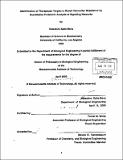Identification of therapeutic targets to revert tamoxifen resistance by quantitative proteomic analysis of signaling networks
Author(s)
Saito-Benz, Hideshiro
DownloadFull printable version (21.82Mb)
Other Contributors
Massachusetts Institute of Technology. Dept. of Biological Engineering.
Advisor
Forest M. White.
Terms of use
Metadata
Show full item recordAbstract
Tamoxifen resistance is the biggest problem in endocrine treatment against hormone receptor positive breast cancer patients. HER2 is a membrane receptor tyrosine kinase that is known to correlate with poor disease outcome and unresponsiveness to endocrine treatment. Although much work has been done over the past decades to elucidate pathways involved in HER2 receptor signaling, the map of network-wide signaling events that contributes to the resistance to Tamoxifen treatment has not been characterized, making it difficult to pin-point the downstream drug target to revert the Tamoxifen resistance. To gain a molecular understanding of the mechanisms by which cells gain drug resistance, we have employed a proteomic analysis by mass spectrometry to quantitatively analyze cellular tyrosine phosphorylation signaling events in breast cancer model systems and human tumor samples. As a result of research, we have identified the major differences in downstream signaling pathways between Tamoxifen sensitive and Tamoxifen resistant breast cancer cell line models. These findings were further analyzed in Tamoxifen sensitive, and Tamoxifen treated/recurred patient samples to study clinical relevance. Specifically, we determined that P13K/Akt, MEK/ERK, and Src/FAK/Abl pathways are major components of the Tamoxifen resistance. We further showed that they signaling components are possible drug targets to revert Tamoxifen resistance. This study revealed cell-context specific network-wide changes in signaling events in response to use of therapeutic drugs. This is, to our first knowledge, the first phosphoproteomic analysis of the signaling network in breast cancer to address Tamoxifen resistance. We believe that same approach is applicable to other drug resistance problems in various disease settings.
Description
Thesis (Ph. D.)--Massachusetts Institute of Technology, Dept. of Biological Engineering, June 2009. "April 2009." Cataloged from PDF version of thesis. Includes bibliographical references.
Date issued
2009Department
Massachusetts Institute of Technology. Department of Biological EngineeringPublisher
Massachusetts Institute of Technology
Keywords
Biological Engineering.